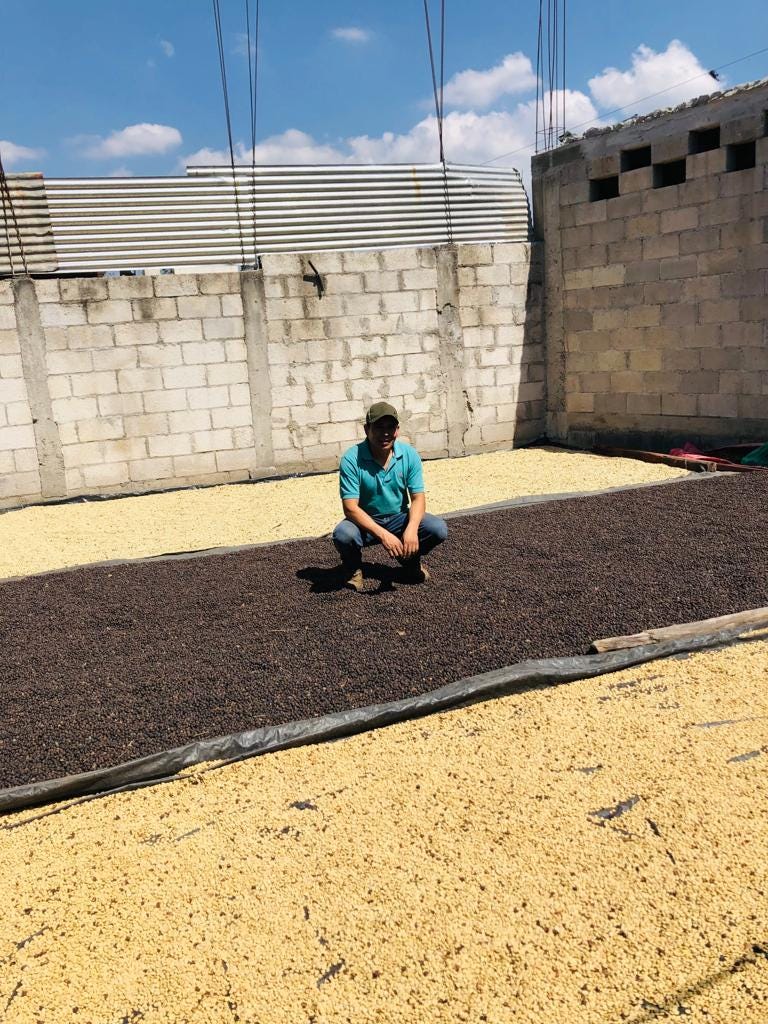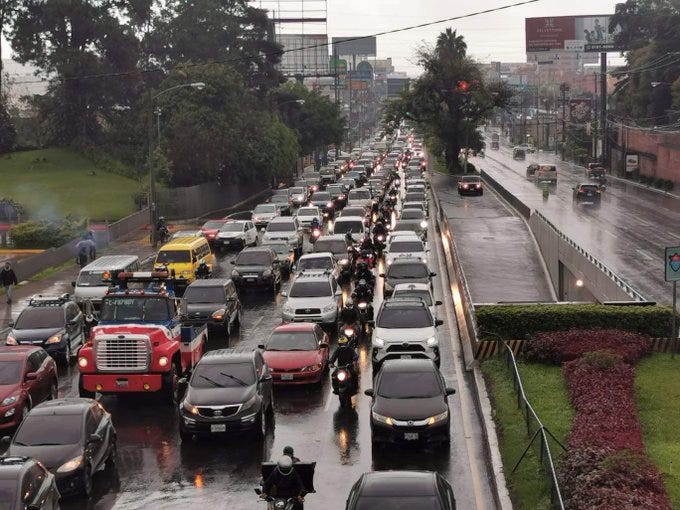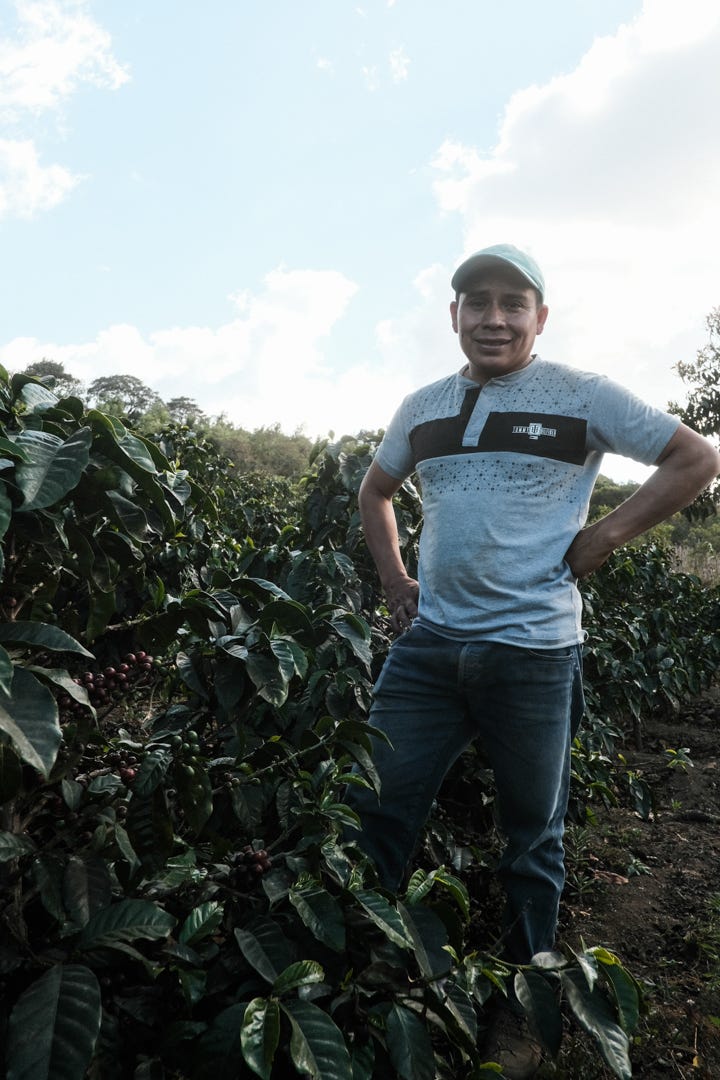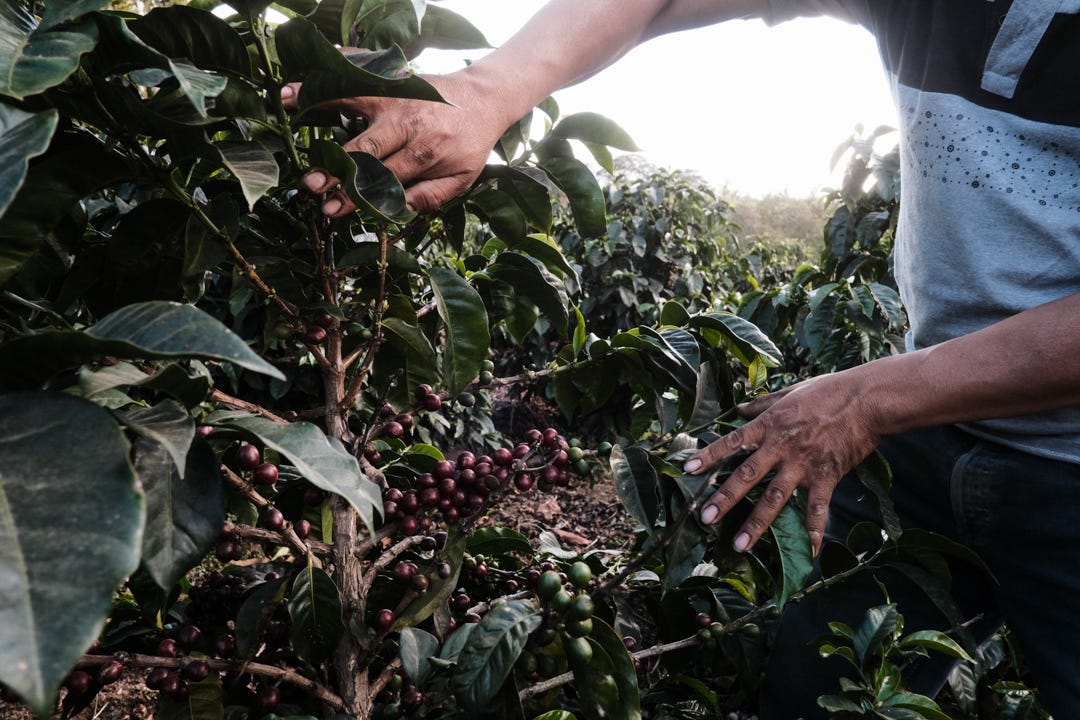What's it like to be a Guatemalan coffee farmer?
Meet our first farmer partner, Manuel Gutierrez
First Encounters
In 2019 I was working in Guatemala with the nonprofit social enterprise De La Gente as a quality control advisor. As the coffee harvest was underway, I was cupping samples from the members of one of the cooperatives that De La Gente served in order to ascertain the quality of that year’s harvest.
Overall, the quality of the coffee was quite good, but one sample stood out on the cupping table from the rest. The flavor profile was so striking that I can still remember it today: intense, fruity, and with a bright acidity that was balanced by high degree of sweetness. It tasted like sautéed yellow and orange cherry tomatoes, the ones that are candy sweet off the vine. This was my first introduction to Manuel Gutierrez.
When I later met Manuel in person, I learned that he was friendly, good-natured, and young. He told me the sample that he had dropped off was a “natural process” coffee, meaning that it had been dried inside the coffee cherry rather than depulped and fermented. This style of coffee processing is more common in Africa than Central America for climactic reasons, as the latter’s more humid weather during the harvest can make the drying of natural process coffees quite challenging.
But I soon learned that Manuel hadn’t just gotten lucky with this lot. He turned in several excellent samples of washed coffees during that harvest, and I also learned that the previous year he had won his cooperative’s microlot competition, turning in the best coffee from among the 30 or so members, many of whom had decades of experience in coffee (he would go on to win that year, 2019, as well).
During that harvest and the next, Manuel and I talked a lot about coffee, and I got to know him enough that, as the idea for what eventually would become Biota Coffee took shape in my mind, Manuel was always the person I imagined working with first. To me, he was the perfect candidate. Not only was he able to deliver high-quality coffee, but, critically, he had an appreciation for organic methods and an open mind to trying new techniques.
I wouldn’t say Manuel represents the “average” Guatemalan coffee farmer, but only because I don’t believe there is such thing as an “average” coffee farmer at all— every farmer I’ve ever met is irreducibly individual in their own unique way. However, many of Manuel’s experiences do represent a large swath of Guatemalan and Central American life today, and those experiences are important, not to mention fascinating, to understand.
The world’s worst commute inspires inspires dreams of a better life
A while back, I asked Manuel why regenerative agriculture is important to him. He responded that he hoped to contribute to a future of cleaner air for his daughters. I thought this was an oddly specific answer until recently, when I asked him why he got into coffee farming in the first place. I knew that he worked in construction previously, but not much more than that. Again, he mentioned air quality, saying that he wanted to be able to breathe better air as well as spend more time with his family.
He explained that for 10 years he worked in construction, but in Guatemala City— a critical geographic detail, given that Manuel lives in Ciudad Vieja, which is just outside Antigua. Now, as the crow flies, Antigua and Guatemala City are only about 25 miles apart. But, since each city sits in a different valley, the main route connecting them is a circuitous, winding road through mountain passes that takes, theoretically— very theoretically— about an hour.
Furthermore, Guatemala City, like all Latin American capitals, experienced an urban population boom in the middle 20th century in which, practically overnight, a huge urban working class sprang up faster than city infrastructure could ever hope to keep up.
Guatemalan City traffic is notoriously some of the worst in the world, and the main artery connecting the City to Antigua, is the Calzada Roosevelt, a three-ish lane of unrestricted traffic warfare— jacked-up buses billowing diesel smoke, motorcyclists dodging between lanes, and street vendors selling bottled waters and chips in stand-still conditions. All of the traffic between Guatemala’s two largest cities runs through here.
On each side of the road is a concrete moat of office buildings, strip centers, new construction, and gated residences. I’ve been stuck in this exact stretch a few times, and I can confirm that there is nothing to do but breathe fumes for however long you are stuck in it, and sometimes you can be stuck for an hour just to go a few miles.
A typical day for Manuel meant leaving his house at 4 a.m. to take a bus into Antigua, and from there another into Guatemala City. At the end of the workday, he might leave at 5 p.m. and not arrive home until 9 p.m. Some days he would just sleep over in the city, as it wasn’t worth it to come home. This was his experience for ten years, and continues to be for thousands of Guatemalan laborers like him in a country marked by deep inequality and chronic underemployment.
One plot at a time
So, Manuel saved up and bought a tiny plot of land, and eventually another, and then another. Most of his plots are extremely high up the mountainside. The reason for this is that, being harder to access, these plots were the cheapest. Luckily, with coffee, the extra elevation opens up the possibility of more complex cup qualities.
Manuel’s experience here is a specific instance of a longer history of land distribution in the region, whereby the older colonial elites came to own the flatter sections of Central America’s valleys, displacing indigenous and mestizo populations up into the hillsides.

This colonial heritage remains fully entrenched today, as all around Antigua you can see the vast holdings of large, multigenerational estates in the low-lying areas, while the slopes all around are subdivided into small sections, indicating a diversity of small holdings.
It took Manuel years to buy enough land to support himself from coffee alone. That means years of the brutal journey into and out of Guatemala City during the week to perform tough physical labor, and then on weekends, a one-hour commute on foot up the mountain to work even more.
“La vida me va enseñando”
“So where did you learn about coffee cultivation?” I asked Manuel.
“Pues, la vida me va enseñando,” Manuel responded: “Life keeps teaching me.” He is essentially a self-taught farmer. At times, he’s been able to glean insight from his fellow cooperative members, although many of them come from similarly non-coffee backgrounds as his.
Other times, necessity dictates the process. Manuel and I once speculated as to why his coffee had a more complex acidity than other coffees from the same area, as if it had been subjected to a longer, slower, lower-temperature fermentation.
He told me that many days, he would pick coffee by himself, and, being too tired to carry his sacks of ripe cherries back down the mountain, he would leave them in the fields to retrieve the next day. In fact, the process of “resting” the coffee for 12-24 hours before depulping is a common practice, and the cool nighttime temperatures at high altitude would absolutely be beneficial to cup quality in this case.
To a certain extent, though, coffee work just comes with the territory. Manuel told me that he wasn’t completely unfamiliar with it, given that since childhood he accompanied his family to pick coffee at any of the local estates during harvest time.
This kind of seasonal, casual work is part of the culture in coffee country, so much so that a scene of picking coffee is even depicted on Guatemalan currency.
Uncertainty— the only thing you can count on
It’s been a rough couple of years for farmers like Manuel. In developing countries like Guatemala, the COVID pandemic meant strict lockdowns and enormous strain on an already fragile healthcare system.
But even as the worst of the pandemic seems to be subsiding, the economic ripples from the disruption in global supply chains continue to be felt. The entire region of Central America had a down coffee harvest, so while low supply relative to strong demand from consuming countries pushed coffee prices upward, there simply wasn’t much coffee on the trees to to sell in order to profit off of the high prices.
Furthermore, prices for gasoline and fertilizer have more than doubled, effectively negating any windfall farmers might have enjoyed from higher coffee prices. For our part, we re-wrote our contract with Manuel to take into account his cost increases, but the real economic benefits from our partnership are still a year or two out, as the trees planted on his plot mature and the ground cover grows in, lowering the costs of his inputs and raising his plots’ natural resiliency.
Nevertheless, this year Manuel is all positivity. He put his construction experience to good work building an enormous worm compost setup in the lower level of the house that he is building himself little by little. His plan is to move his family into this newer home in the next few years. Next year’s harvest looks to be much better than this year, and as his input costs continue to fall, Manuel’s profitability will continue to rise.
Even though we at Biota and Manuel cannot predict what will happen in these crazy times, one thing we can all be sure of is that we have each others’ backs. One thing I’ve learned in my time working in coffee is that who grows, harvests, and processes coffee really does matter. The quality of your daily cup of coffee is indirectly but undeniably affected by the social conditions under which it was produced, even if those conditions are often invisible to the end consumer. That’s why our relationship with Manuel always comes first— the social sustainability is what unlocks the potential for environmental sustainability, and that’s what makes this whole scheme economically sustainable for everyone.













Thanks for this great article. I have a much better appreciation for the effort, skill, commitment and circumstances that influence sustainable coffee growing and flavors. Thanks to Manuel and Biota for your hard work and commitment!